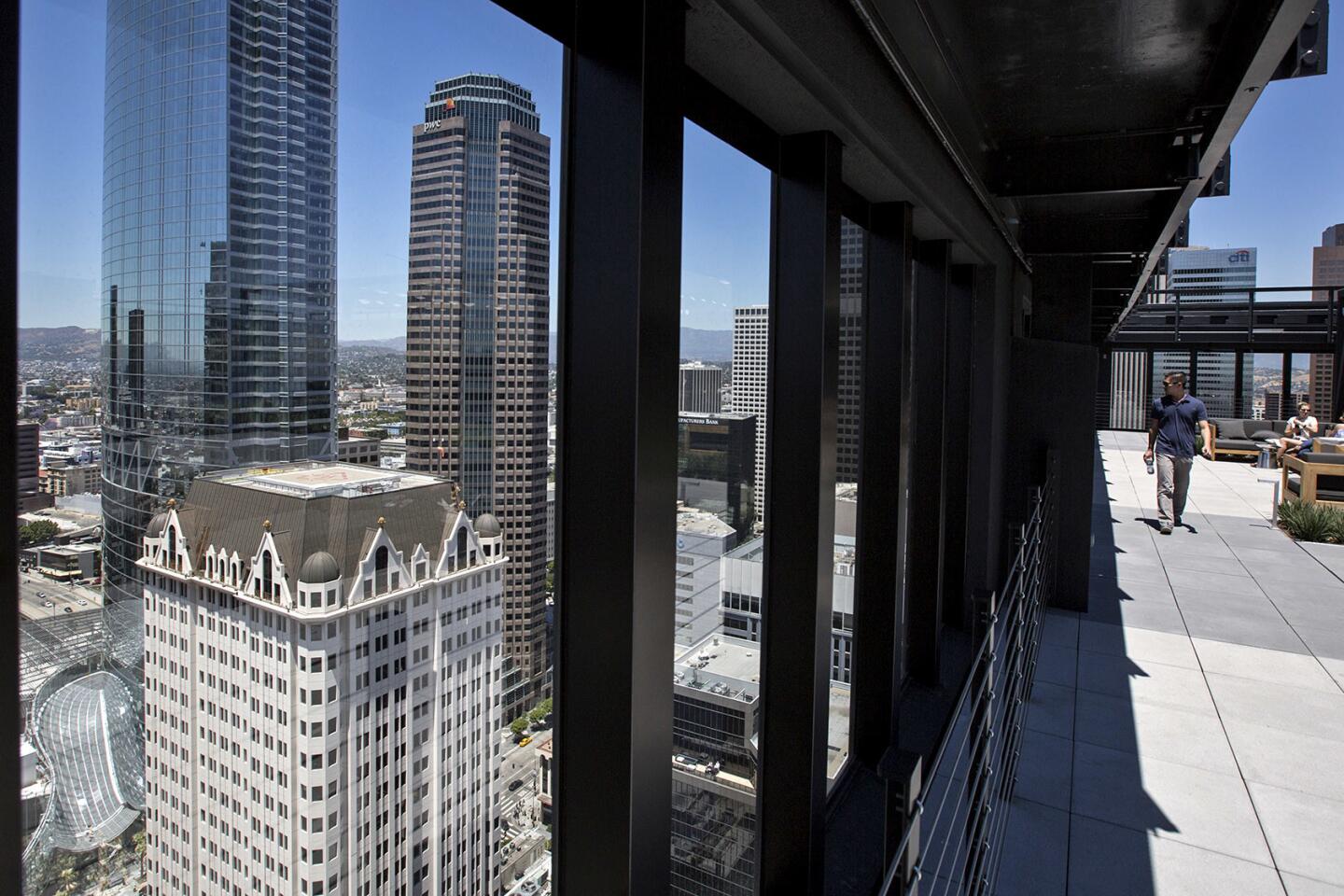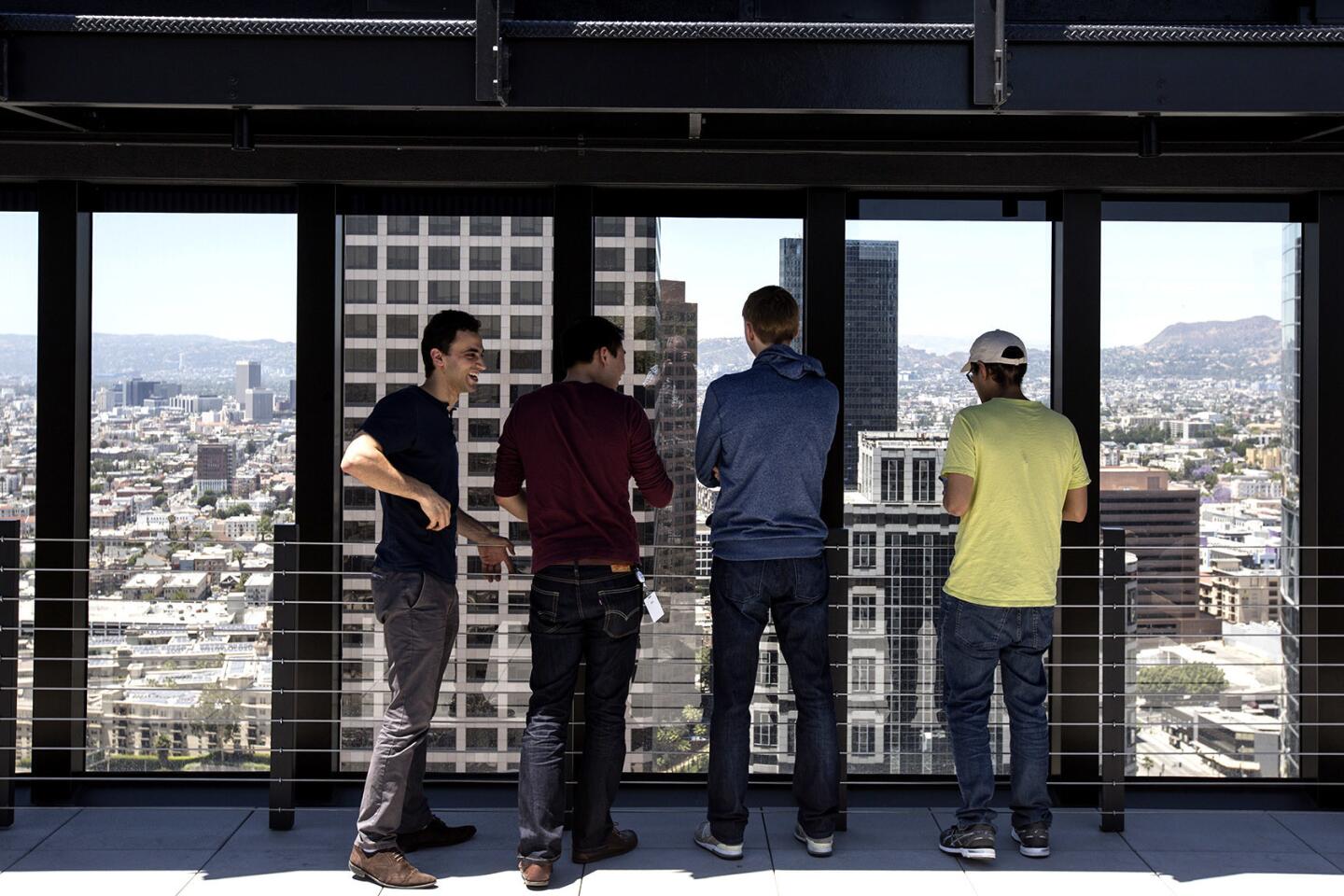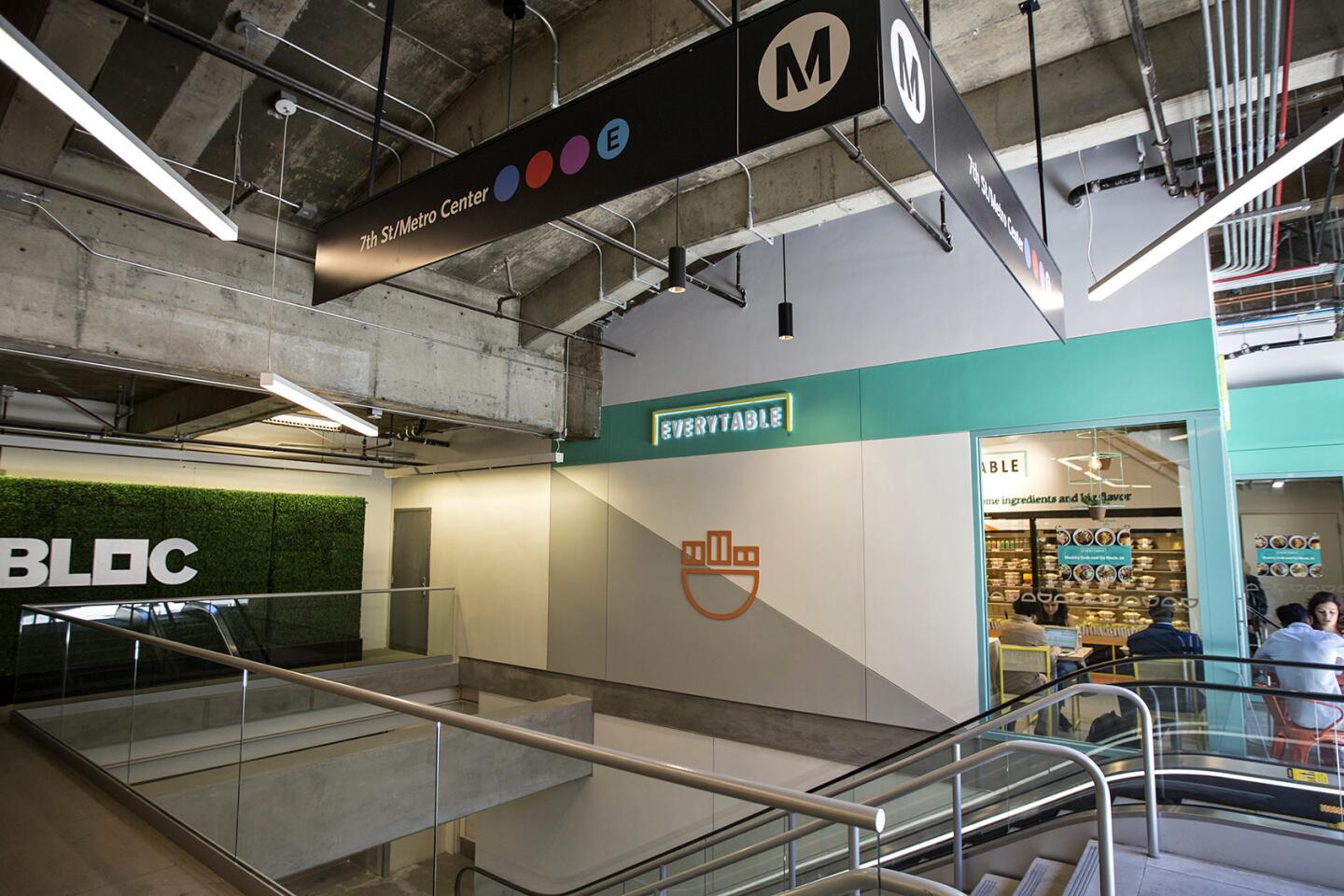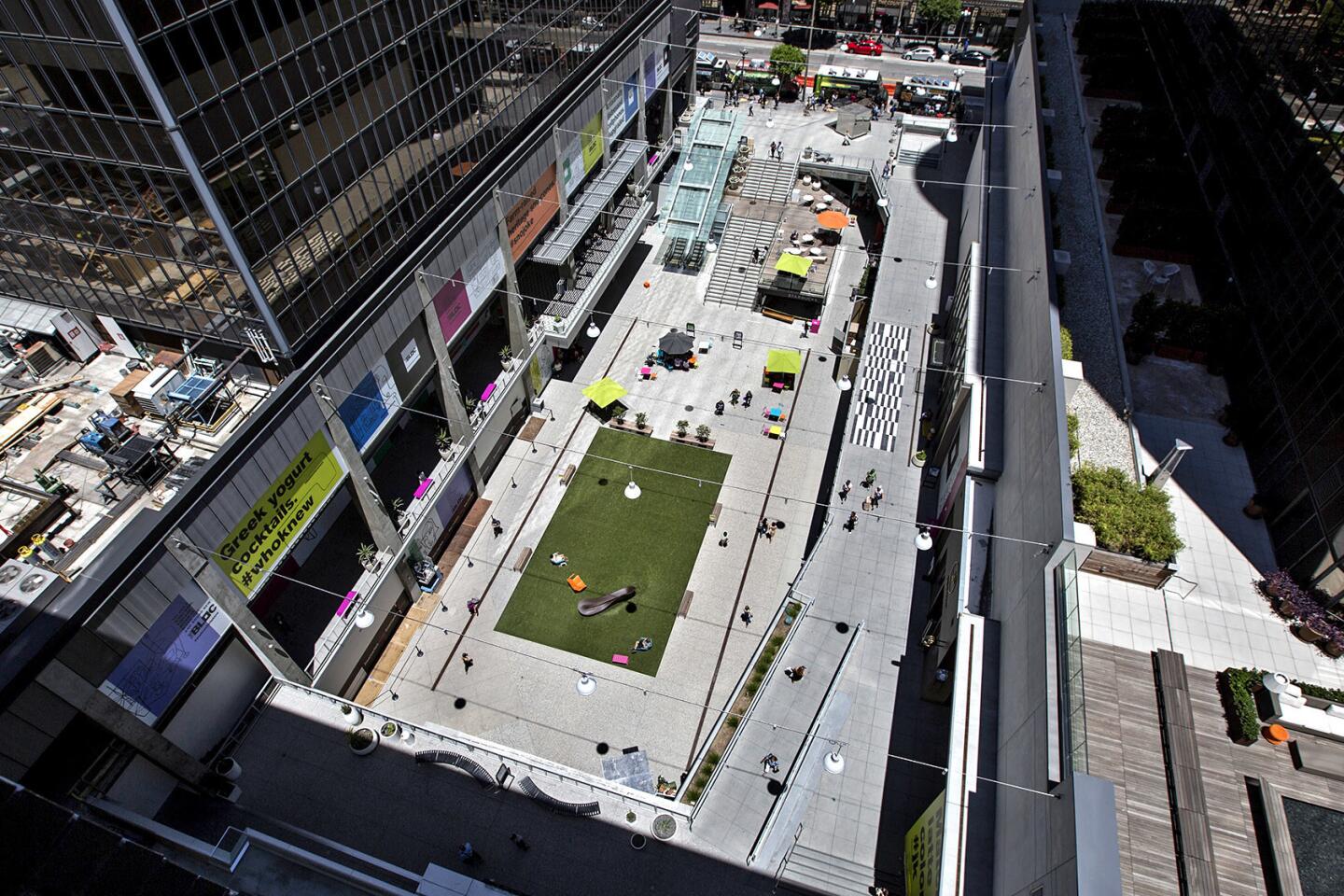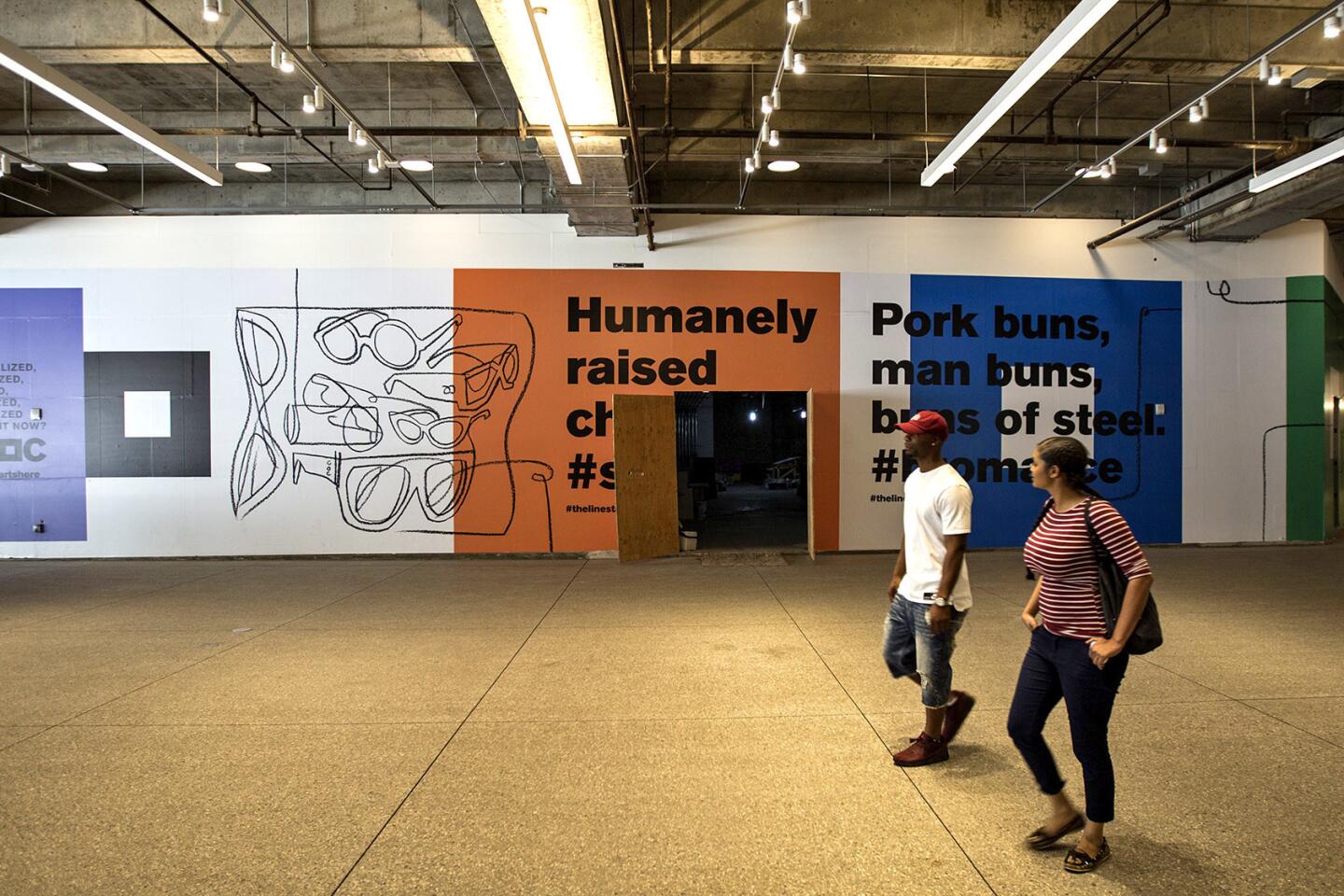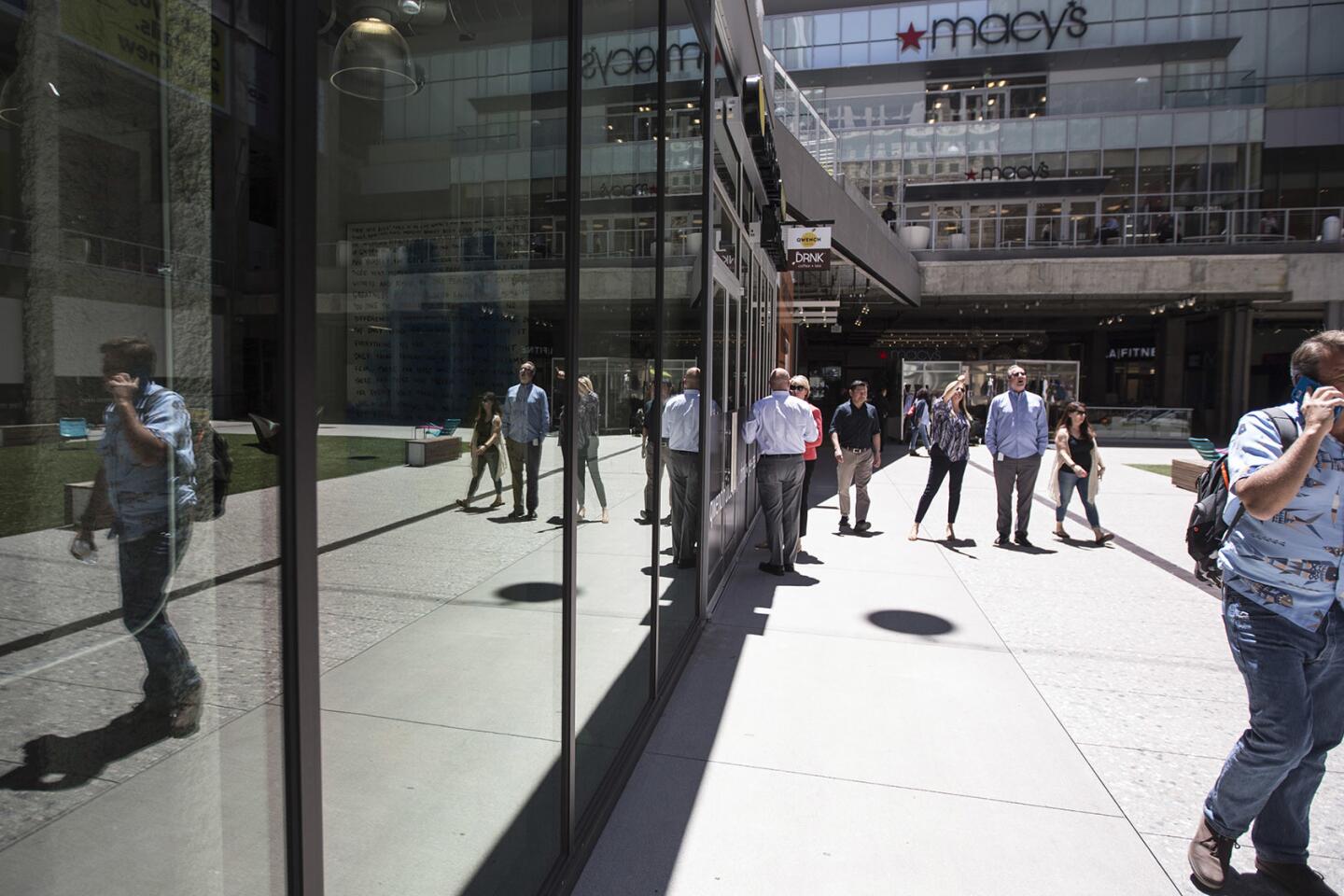$250-million makeover of a downtown L.A. mall is back on track as Alamo Drafthouse signs on
- Share via
Alamo Drafthouse Cinema, a quirky beer-selling theater chain, has formally agreed to open an outpost in downtown Los Angeles — news that comes with a sigh of relief for a local real estate developer laboring to overhaul an aging mall.
It’s been almost three years since the Texas-based cinema group said it was coming to help anchor the transformation of the Bloc from a bunker-like indoor mall from the 1970s into an open outdoor center.
For the record:
4:57 p.m. Jan. 24, 2025This story incorrectly refers to a new coffee shop at the Bloc as a Starbucks Craft Bar. It is called a Starbucks cafe. The story also says the store may serve beer and wine. In fact, it will not serve alcohol.
The ambitious makeover by Los Angeles developer Ratkovich Co. hit turbulence, however, running substantially over budget and a year and a half behind schedule. Prominent announced tenants such as Davio’s Northern Italian Steakhouse pulled out as Ratkovich failed to deliver space on time.
The fact that Alamo still hadn’t signed on the dotted line loomed as a potentially harsh blow to the Bloc. In addition to Macy’s, the theater chain is expected to be the biggest retail anchor driving traffic to the mall.
But with Alamo’s announcement Thursday, Ratkovich Co. President Wayne Ratkovich says the troubled project is finally coming together.
“With the addition of Alamo Drafthouse and our positive leasing momentum, space will soon be a scarce commodity at the Bloc,” he said. The mall is now 76% leased.
The makeover was never going to be easy.
Ratkovich, who has renovated such historic Los Angeles landmarks as the Wiltern Theater and Howard Hughes’ former offices at Playa Vista, launched the project just as many malls started closing stores — reeling from over-expansion and growing online competition. Unexpected construction issues slowed work and helped drive costs well over the original $180-million budget.
He wanted to radically make over the shopping center, 496-room hotel and 33-story office tower that made up the former Macy’s Plaza without shutting the place down. Ratkovich removed the mall’s glass atrium roof and ripped out ground-level brick walls to create stores and restaurants on the adjacent sidewalks.
He removed much of the main floor to create a sunken, sunlight-filled public plaza. There his workmen hacked through a thick concrete wall to open a direct portal to the busy 7th Street/Metro Center subway station, encountering foundational concrete piles and thick steel reinforcing bars that didn’t show in the mall’s original plans.
The hulking garage for 2,000 cars was also renovated.
“It’s a massive undertaking,” Ratkovich said.
The price of the makeover jumped $70 million to more than $250 million, in part because of deliberate spending increases such as the upgrade of the shabby old Sheraton hotel into a Sheraton Grand. Ratkovich believes that the projected income of the improved center will justify the extra cost. The average occupancy at Sheraton Grand is already more than 90%, up from 70% before the makeover, and average daily room rates have risen about $50 to $210, he said.
The makeover has also taken about 18 months longer than expected, in part so that existing tenants could move to different locations in the mall so work could proceed around them.
As the process dragged on, some prospective tenants bailed out because their move-in dates were delayed.
Davio’s, gelato store Popbar and Killer Cafe restaurant chose not to wait. Signing them at the outset of the redevelopment process turned out to be a mistake.
“We started too early,” Ratkovich said. “While we lost some, we gained more than we lost.”
Among the newcomers are Free Market, a collection of upmarket independent retailers, and a Starbucks Craft Bar that may sell beer, wine and food in addition to specialty coffee.
Trying to lease retail space in the early stages of redevelopment can be a tough sell, said retail real estate broker Matthew Fainchtein of Cushman & Wakefield, who does not represent the Bloc.
“Fancy renderings are nice, but the reality is that most people, until they see the design in person, find it really hard to imagine what it’s going to be like,” Fainchtein said.
The Bloc “announced deals before they were truly completed, and that comes back to haunt you,” he said. “You hear about one deal after another that didn’t happen and you wonder what’s wrong.”
Sill, the Bloc is “a viable, well-done project,” he said. “They have done a great job with some of their merchandising. Alamo will be a big hit.”
The rise of the neighborhood around the mall is working in its favor. Thousands of apartments, condominiums and hotel rooms have been built nearby in recent years and many more are on the way.
“It’s in the heart of downtown,” Fainchtein said.
Macy’s, which completed a major renovation of its three-level store in the Bloc a year ago, is already reaping the benefits as new residents and tourists come to shop, manager Henry Aguirre said.
Macy’s elevated its offerings with “big brands with big footprints” such as Michael Kors, Coach and Kate Spade that appeal to international visitors, Aguirre said.
Macy’s also scaled up its furniture and home furnishings to entice millennials moving downtown. It had been more than 25 years since Macy’s attempted to sell furniture there when the store converted its food court to a showroom as part of its makeover.
The downtown store saw the biggest year-over-year improvement in sales in the Macy’s chain for the fall season and is on track to keep that most-improved title again for the spring season, Aguirre said.
The introduction of new brands and physical improvements to the store are part of Macy’s strategy to compete with Internet-based retailers.
“We are trying to create that shopping experience that they can’t find in competition like Amazon or off-price” retailers, he said.
Pasadena retail consultant Peter Lynch said that in-person experience will be crucial to fend off the convenience of online shopping.
“If you can differentiate yourself, you can excel,” he said.
The newfound success of the downtown Macy’s may prove a tipping point as big chain retailers return after decades when most of them were absent, real estate broker Hal Bastian said.
“It’s taken a long time for national retailers to embrace downtown because they were catering to the suburbs,” he said. “Now it’s different.”
Target, H&M and Zara are among the big retailers at Figat7th shopping center near the Bloc that are new to downtown L.A. Nordstrom Rack will move in this fall.
Meanwhile, the Bloc will mark Alamo Drafthouse’s first foray into Southern California. The company plans to open 12 screens with a combined 560 seats next year.
The complex will be equipped with modern 4K digital projection, along with 3-D capability and conventional 35-millimeter projection to show classic movies, Chief Executive Tim League said Thursday.
That addition is helping downtown reclaim its former prominence as the city’s center of entertainment, business and commerce, Ratkovich said.
Decades ago popular department stores such as Bullock’s, Broadway, May Co. and Robinson’s drew throngs of shoppers to a thriving retail district.
The stores followed families to the suburbs in the latter part of the 20th century and downtown withered until a renaissance began around 2000.
“Now downtown is returning to the role it once had as the center of Southern California,” Ratkovich said.
Twitter: @rogervincent
ALSO
Legendary Formosa Cafe in West Hollywood to reopen with new operator
Dearden’s furniture stores to close after 108 years in Los Angeles area
Is the real estate market about to crash? No way, says this CEO — and here’s why
More to Read
Inside the business of entertainment
The Wide Shot brings you news, analysis and insights on everything from streaming wars to production — and what it all means for the future.
You may occasionally receive promotional content from the Los Angeles Times.

